Products
Mopeds
Minibikes
Utility
Media
Photo gallery
Tomos history
Tomos racing
Moped fans
Tech corner
BT 50 Engine Data
A5 Engine Data
Tuning
Troubleshooting
Spare parts
Editorials
A5 Colibri
Dealer horror stories
Testimonials
Tomos™ Nederland
White papers:
Gearbox oil
Anti-theft
| Home |
WARNING!Procedures described herein should not be used on mopeds which are used in public traffic. Tuning can damage mopeds and result in injury or loss of life. Author is not responsible for damage to people or objects which may result in following these instructions. |
Tuning
- Overview
- Performance monitoring
- Speed/power relation
- Engine tuning
- A5 engine price/performance tune up
- Suspension tuning
Overview
Moped tuning is a procedure of modifying or changing certain moped parts or units to achieve desired operation. Object of tuning is mostly the engine, but also brakes, suspension, bodywork,.. can be modified.Performance monitoring
It's almost impossible to tune a moped without monitoring the speed and acceleration. Almost everything can be calculated out from these two variables and therefore an accurate measuring system is in order. When performing multiple measurements make sure you do them in same environment (weather conditions) and follow same procedures (driving position) and settings (warm engine, tire pressure,..).Measuring speed
Although most mopeds have a speedometer, it's too inaccurate and thus inappropriate for exact measurements. A practical and efficient solution is a bicycle speedometer of good quality (e.g. it should at least measure in 1 km/h steps). Warning! Magnet and the reed switch should be mounted as close as possible to the wheel axle to eliminate clapping between the two.Measuring acceleration
Acceleration measurement equipment is very expensive. Fortunately there is a very simple alternative. Acceleration can be measured between two points with a help of an ordinary computer with a sound card and a portable tape recorder. First you have to find a straight road or a parking lot. Then you have to mark the two points of measurement (start and end), which must be around 100 m apart. Place a small air-filled pouch (or anything else that makes a pop when driven over) on the two points. Acceleration can now be measured by driving over the two points (e.g. over those two things that pop) with the tape recorder running. You can also use the horn if you like instead of the pouches, but this is not as accurate. Just make sure you start at the first point and drive straight to and over the second. Now sample the recorded sound into the computer. Find the two pops and establish time between them in a sound editing program. When you have this information, you can calculate the acceleration, speed at second point and engine power.| Variables | a- acceleration [m/s2] s- path [m] t- time [s] |
V- speed [m/s] a- acceleration [m/s2] t- time [s] |
F -force [N] a- acceleration [m/s2] m -mass [kg] |
P -power [kW] F -force [N] V- speed [m/s] |
| Equation | a=2s/t2 | V=a*t | F=a*m | P=F*V |
Speed/power relation
With engine tuning more power and/or torque is produced to increase engine performance. But an important fact must be taken into consideration:Air resistance increases with speed2. |
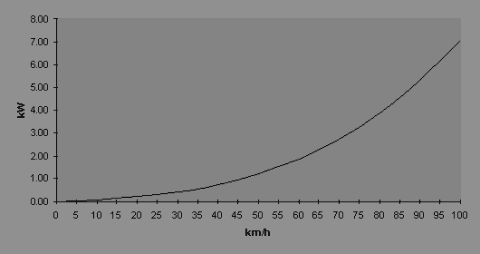 |
This simply means that power demand for increased speed isn't linear, but progressive. Example: to achieve twice the speed you would need eight times the power (23). Required power depends on three factors: top speed, total resistance factor (which derives from three components) and power output correction factor.
| Variables | R- total drag [kg] Ra- air drag [kg] Rr- roll drag [kg] Rc- slope drag [kg] |
Ra- air drag [kg] cw- air drag coefficient V- speed [km/h] A- transverse area [m2] |
Rr- roll drag [kg] W- weight [kg] |
Rc- slope drag [kg] ß- slope angle W- weight [kg] |
P- power [kW] R- total drag [kg] V- speed [km/h] n- transmission effectiveness |
| Equation | R=Ra+Rr+Rc | Ra=0,0048*cw*A*V2 | Rr=0,02*W | Rc=sin ß*W | P=(R*V)/(n*367) |
Calculated cw based on Tomos™ factory data for A35 moped models is approximately 0,60. Above diagram derived from A= 0,7 m2, W= 135 kg, ß= 0°, n= 88% (0,88).
Equations show that higher speeds can be achieved by means of:
|
Engine tuning
Knowing how a modern two stroke moped engine works is necessary for understanding the instructions. Older moped models with smaller brake shoe diameter (90 mm) should not be tuned as they do not provide necessary braking capability.Price factor often determines the extent of engine modifications. Tune up pricing range stretches from as little as 30 $ to more than one third of the price of a new moped, but it's quite easy to achieve good results for a fair price with using modified original parts. Of course many kits are available and are a good choice if you don't have the proper tools, materials or machinery for a tune up, but it costs a lot more than the do-it-yourself approach. Most of the kits that are sold are not originally made for Tomos™ engines, but for Puch engines and are only modified to fit Tomos™. Because of this these kits don't have intake reed valve (and consequently cannot perform well at low RPM because of filling losses) and because of the different intake manifold pre-mix isn't possible after the tune up.
Related topics: A5 engine data sheet
A5 engine price/performance tune up
This tuning, which offers best price/performance rating, increases the power and torque of the engine. On the 49 km/h engine version, top speed is increased to 72 km/h (speedometer indication; real speed around 65 km/h) with original sprockets. Because the intake manifold isn't modified, pre-mix is possible after the tune up. It consists of five steps:| Moped part | Modifications |
| Thermal unit | Increased cylinder volume and port opening timings. |
| Spark plug | Higher thermal value. |
| Carburetor | Enlarged main jet. |
| Exhaust | Shortened exhaust manifold or a sport exhaust. |
| Transmission | Modified sprocket ratio. |
1st step: Honing the cylinder
Cylinder must be honed accurately and in accordance with the table below (Both diameters are measured 10 mm from cylinder edge).| Top diameter | Bottom diameter |
| 42.010+0.01 mm | 42.020+0.02 mm |
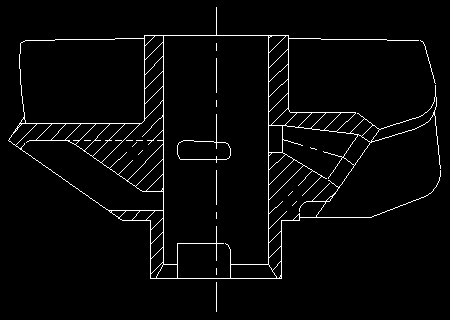 |
This way, the piston displacement is increased to 59.6 cc. Original piston is replaced with a 42L piston. Because of increased diameter reed valve support must be shortened to the extend that it doesn't reach the piston (this is reed valve version dependent).
| What does increased volume do to engine torque? Crankcase compression is increased and this consequently shifts maximum torque to higher RPM and enables achieving higher speed (under condition that the engine has enough power). This can sometimes lead to narrowing the usable RPM range and decreased engine flexibility. In other words, if RPM drops below usable range under heavy load, performance decreases, for example when riding in strong wind or up a steep hill. Problem of the "torque hole" can be compensated with an expansion chamber designed for high torque at mid RPM or/and with a boost bottle. |
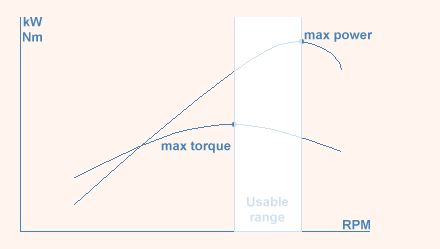 |
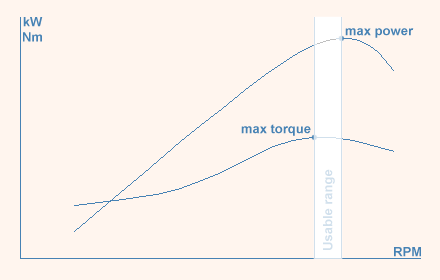 |
| Note: Diagrams are given as an example therefore no units are used. |
2nd step: Replacing the spark plug
Original spark plug is too cold for a tuned engine and has to be replaced with a warmer spark plug. Correct thermal value is established by testing and comparing results with Spark plug condition table.3rd step: Fabricating the cylinder gasket
Cylinder gasket is installed between the cylinder and the crankcase and is applied to maintain the original compression ratio and to increase exhaust and transfer ports opening timings. It's fabricated from aluminium of 1 mm thickness.| Ports before | Ports after |
| Transfer 94 deg Exhaust 135 deg |
Transfer 103 deg Exhaust 142 deg |
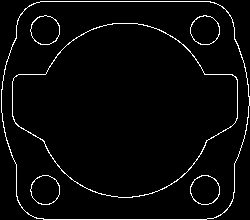 |
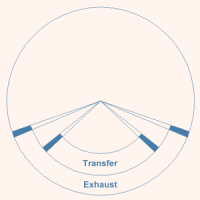 Ports PortsIn tuning instructions described here port opening timings are extended by raising the cylinder with aluminium gasket. This is the easiest way to do it. As exhaust and transfer ports are open for longer time periods, this enables more gas mixture to pass through into the cylinder and consequently increases power. Modification is easily seen from the polar distribution diagram (gain is blue area on the diagram). |
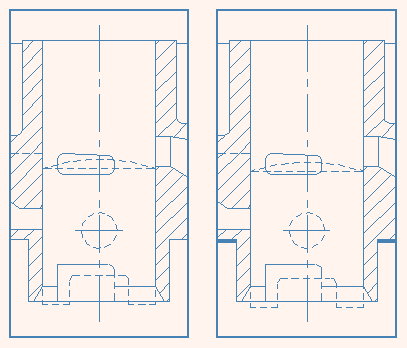 |
4th step: Main jet adjustment
Main jet diameter determines the fuel flow at fully open throttle. Therefore for achieving more power at high RPM the main jet diameter needs to be enlarged. Bad side of this modification is increased fuel consumption. Appropriate main jet diameter is established by running the engine at full throttle for some time and then comparing results with spark condition table. If the engine overheats, use bigger jet. If black deposits occur, use smaller jet. Always use bigger jet diameters first, otherwise the engine could overheat.5th step: Exhaust modifications
Original exhaust is designed to achieve power spreading through a very broad RPM range thus making the engine very flexible. To achieve higher RPM, exhaust tuned length has to be shortened. This is done by replacing the original curved exhaust manifold with a straight short one. Because of high difficulty of this modification and the fact that currently only the Colibri exhaust can be modified this way, replacing the complete exhaust with a sport version is recommended (of course new exhaust has to be perfectly tuned to changed port opening timings, otherwise no power increase is achieved).| Resonance exhausts This is the most popular and widely accepted field of two stroke engine tuning. You will find all information about this topic on countless internet sites related to engine tuning. |
6th step: Changing sprocket ratios
When replacing the front sprocket with a bigger one (more teeth) more top speed/less acceleration is achieved and when replacing the front sprocket with a smaller one (less teeth) more acceleration/less speed is achieved. Rear sprocket replacement has the opposite effect. However, because of small front and rear sprocket teeth difference and space limitations on A5 engine high modification of the ratio is not possible.| Correct sprocket transmission ratio By changing front and/or rear sprockets optimum acceleration or top speed is achieved. With correct sprocket transmission ratio the engine is kept within highest torque RPM range when shifting thus allowing maximum possible acceleration at given power. |